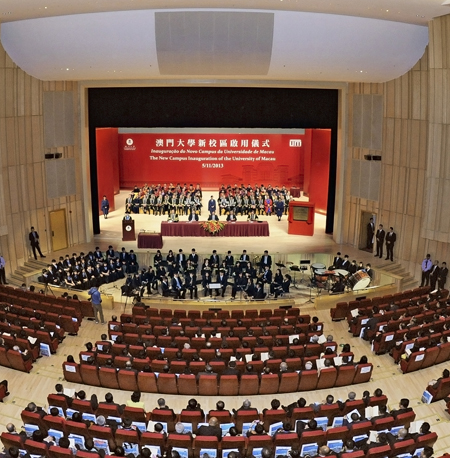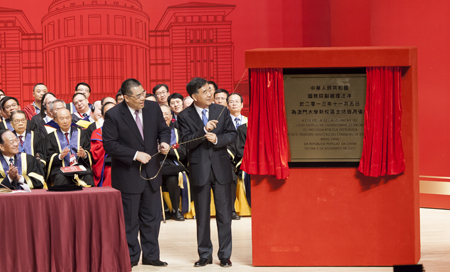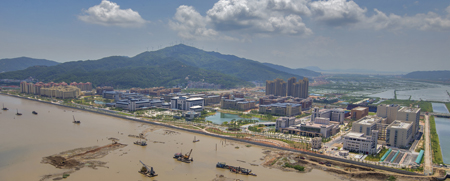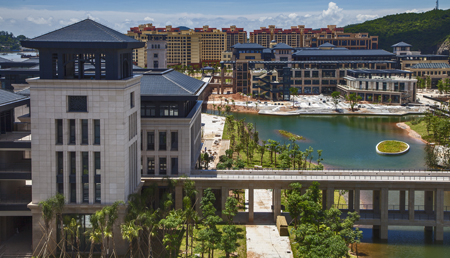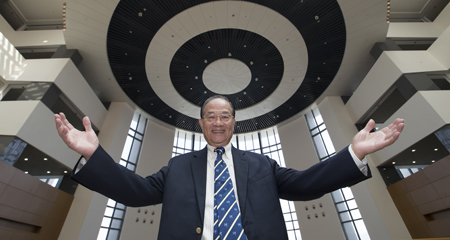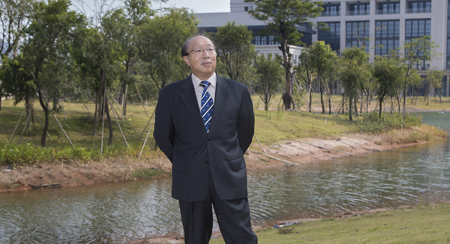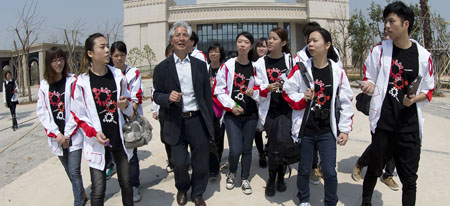On 5 November 2013, the University of Macau (UM) held an inauguration ceremony for the new campus. Officiating guests included Wang Yang, vice premier of the State Council; Chui Sai On, chief executive of Macao SAR and chancellor of UM; Edmund Ho Hau Wah, vice chairman of the National Committee of the Chinese People’s Political Consultative Conference; Tse Chi Wai, chair of UM’s University Council; and Wei Zhao, rector of UM. Over 500 guests attended the ceremony to witness the landmark moments, including officials from the central government, Guangdong government, and Macao SAR government; prominent community figures; as well as representatives of UM staff, students and alumni.
The inauguration of the new campus, which is 20 times larger than the old one, marked the official end of a long chapter in the university’s history where the lack of a decent campus had not only severely hindered its development, but had also prevented the students from enjoying the full experience of campus life. Tse Chi Wai, chair of the University Council, hopes the new campus will change all that.
There is a Chinese saying that, “In order to attract the golden phoenix, the king of all birds, you must first plant the Chinese parasol tree, to create the best environment for the phoenix to thrive.” UM Rector Wei Zhao hopes that the new campus will help to attract more outstanding students and staff so that the goal of developing UM into a world-class university can be achieved.
The famous Russian writer Nikolay Chernyshevsky once said something to the effect that every tomorrow is made up of beautiful dreams of today, and one should love them, embrace them, work for them, and try one’s best to make them come true.
The new campus is a dream come true, and creating better tomorrows begins with hope today. Read on to learn what hopes and expectations UM members have for the new campus and the university.
The New Campus Through Students’ Eyes
A new campus—it used to seem like an impossible dream. Now it’s a reality and will soon be occupied. Of course the new campus belongs first and foremost to the students. So what expectations do our students have for the new campus and for themselves in that new environment?
QUESTION 1: What are you most looking forward to about the new campus?
QUESTION 2: How do you plan to better prepare yourself for future challenges?
Chan Chong Hei, Paco Macao Faculty of Business Administration 4th-year undergraduate
1. I most look forward to the large space and the new library. I hope to be accepted by the residential college of my choosing. I hope the residential college can help enrich my campus life.
2. I hope the new campus can help me to learn better, to make more friends, and to better prepare myself for the future.
Huo Ran, Rita Mainland China Faculty of Arts and Humanities 2nd-year postgraduate
1. I hope the new campus is more international, with more diversity, a richer cultural atmosphere, and a better research environment.
2. As a PR Student Ambassador, I hope to spread UM’s educational philosophy to more people. I also hope to gain more experience in guiding tours. I hope to live and learn with my whole heart, so I can be the best I can be.
Leong Hong Ip, Jason Macao Faculty of Social Sciences 4th-year undergraduate
1. I look forward to the various new challenges! Just thinking about the new experiences and challenges that will come with the new environment makes me so excited!
2. I hope to better prepare myself for the various future challenges. What we need most in today’s world is not just expertise, but more importantly the ability to adapt to changes.
Tan Minling, Ling Mainland China Faculty of Social Sciences 4th-year undergraduate
1. I look forward to a different kind of campus life. I think with the residential college system, students will be able to spend more time together, to enjoy a genuine campus life, and to foster deep friendships and make beautiful memories.
2. Real knowledge comes from practice. I hope to apply what I learn to daily life. I also hope to have more chances to exchange ideas with other students so I can listen to different views and know myself better. I also hope to see and try as many new things as possible.
Chang Kin Ian, Monica Macao Faculty of Social Sciences 2nd-year postgraduate
1. I hope the new campus can attract more outstanding international students so we can carry out more in-depth academic discussions with students from different countries and develop a global mindset.
2. I hope to master the Manchu language so I can read documents in this language. I also hope to find a good research subject for my PhD studies. I want to study with the best teacher in the New Qing History.
Chao Lok Kio, Vicky Macao Faculty of Science and Technology 2nd-year undergraduate
1. I look forward to living in a residential college with undergraduates from different faculties and departments so we can learn from one another.
2. I hope to make some changes, to become more confident, to learn interpersonal skills, to face difficulties bravely instead of running away from them.
Mok Wai Kin, Joe Macao Faculty of Law 2nd-year undergraduate
1. I look forward to the colourful residential college life, a bigger campus, better facilities, more food choices, and the chance to meet more friends.
2. I hope to have more time to participate in extracurricular activities. I hope to become wiser, to challenge myself, and to be the best I can be.
Cheang Chi Fai, George Macao Faculty of Social Sciences 3rd-year undergraduate
1. I most look forward to living in a residential college.
2. I hope to improve my interpersonal skills, because the importance of interpersonal communication in daily life just can’t be overstated. The new campus is a good opportunity, and I hope to seize this opportunity to improve my interpersonal skills and to better prepare myself for future challenges.
Eurico Pinto Marques Portugal Faculty of Social Sciences 2nd-year undergraduate
1. I look forward to studying in the excellent environment of the new campus, which I think will motivate students to study more diligently. High-quality restaurants are also important, because students deserve to have a variety of choices. Gym equipment ought to be taken into consideration for those who wish to improve their fitness. The enormous space on the new campus will make it possible to hold more horizon-broadening activities.
2. I hope to improve my communication and collaboration skills. Insightful learning and thinking should not be neglected. With the combination of these skills, students would be more methodical and mature and would be better able to cope with future challenges.
Hoi Wa Heng, Ginny Macao Faculty of Business Administration 3rd-year undergraduate
1. I look forward to living in a residential college where we can learn to live with others in harmony and grow together.
2. I hope to be able to think and learn independently, to observe and analyse more, to dare to question and ask, to not follow the crowd, to develop a crisis mindset, and to improve my competitive advantage.
Gao Hong, Elisa Mainland China Faculty of Science and Technology 2nd-year postgraduate
1. I hope to see more variety in the mode of education and course enrolment at the postgraduate level. I also hope to see summer courses which attract postgraduate students from elsewhere.
2. The greatest challenge for me personally is: how do I graduate with a competitive edge? I also hope to interact with people from different fields and of different personalities, to help me stay hungry for knowledge.
Kwok Chun Ting, Jimmy Hong Kong Faculty of Social Sciences 2nd-year undergraduate
1. I look forward to bicycling through the footbridges, waiting for friends by the lake, and going food-hunting in the University Mall.
2. I hope to stay fit and healthy, to participate in more volunteer activities, to improve social and communication skills, to broaden my horizons, and to learn both inside and outside of class.
The New Campus Through Tse Chi Wai’s Eyes
On 20 December 2009, which marked the tenth anniversary of Macao’s return to China, Hu Jintao, then president of the People’s Republic of China, visited Macao to attend the celebrations and officiate at the groundbreaking ceremony for the University of Macau’s (UM) new campus on Hengqin Island. In his speech at the groundbreaking ceremony, Hu Jintao used five “world-class” designations to express his high expectations for UM (becoming a world-class university with world-class facilities, world-class faculty, world-class graduates, and world-class achievements). Dr. Tse Chi Wai, UM’s University Council chair, thinks that Hu’s high expectations has given UM a new mission, which is to explore a new path to becoming a world-class university which hopefully will benefit other universities in China as well.
Exploring a New Path to World-class Status for Chinese Universities
Tse Chi Wai recalls that in May 2007, at the Joint Meeting of the University Assembly and University Council, which was chaired by Edmund Ho Hau Wah, the first chief executive of Macao SAR, the fact that the lack of a decent campus was stifling the university’s development was once again brought to the attention of the chief executive. In response, Ho Hau Wah suggested that the university should think outside the box, that is, think outside Macao, to see if a piece of land on Hengqin Island could be obtained to construct a new campus. One month later, Tse Chi Wai, along with former rector Prof. Iu Vai Pan and several University Council members, visited Hengqin Island to examine the feasibility of constructing a new campus there. When we stood in the east of the island and looked back at Macao, we couldn’t help but feel shocked, because we might as well have been in Macao,” recalls Dr. Tse. “The feeling was so strong that we immediately thought, ‘What if we build a new campus on Hengqin Island, and then connect the new campus and Macao with a bridge or a tunnel? Wouldn’t that mean that technically the new campus would still be in Macao?’” Upon return to Macao, the team reported the findings of the visit to Ho Hau Wah and Chui Sai On, then secretary for social affairs and culture of Macao SAR, suggesting that the idea of constructing a new campus on Hengqin Island was feasible if a plot of land separated from the rest of Hengqin Island could be obtained with the approval of the central government.
From that time on, UM and the Macao SAR government worked hard to gain approval for this proposal. After more than one year’s negotiations between the Macao SAR government, the central government and Guangdong government, it was decided that the proposal to construct on Hengqin Island UM’s new campus directly linked to Macao be submitted to the Standing Committee of the National People’s Congress for deliberation. When news of this proposal began to spread in early 2009, many in Macao and the neighbouring regions voiced doubts about its feasibility. As Dr. Tse points out, “People expressed concern over immigration clearance, policy issues, legal issues, transport, and many other related issues. So we organised more than 20 consultation sessions before the proposal was deliberated by the National People’s Congress Standing Committee. We consulted the opinions of our faculty members, our students, our administrative staff, our alumni, as well as Macao residents and the SAR government. In other words, we consulted the opinions of people from all walks of life.”
On 27 June 2009, the National People’s Congress Standing Committee adopted the new campus bill, which not only allowed UM to construct a new campus on a piece of land of approximately 1.09 square kilometres in the east of Hengqin Island, Guangdong province, but also authorised Macao SAR to exercise jurisdiction over the new campus to be connected to Macao via an underwater tunnel which is to be built in an area of water under the jurisdiction of China but which shall be governed by the Macao SAR government. This unprecedented decision ingeniously addressed, once and for all, all the concerns Macao people had raised, and proved how much the central government values the opinions of Macao residents.
UM’s new campus is approximately 20 times larger than the old campus. It has a building area of approximately 940,000 square metres, with more than 60 buildings and various teaching, research, sports, recreational and residential facilities. It completely meets former president Hu’s “world-class” expectation, whether in terms of the architectural style or construction standards, which is no mean feat to be accomplished in just a little over three years, and which would not have been possible without the great support of the central government and the Macao SAR government, the close collaboration between Guangdong and Macao, as well as the hard work of UM’s management team.
Dr. Tse thinks that UM should make full use of the advantages of the new campus so that students can have the full experience of campus life. “After we announced the plan to build a new campus, the first major decision we made was to adopt a residential college system,” notes Dr. Tse. “Everyone’s journey of growth is unique, and every university needs to have its own distinctive culture. But this culture can’t be built overnight; it needs to be jointly fostered by our students and teachers over time. The residential college system is a mode of education widely adopted by many world-class universities. By arranging for teachers and students to live together, this system creates more opportunities for teacher-student interaction as well as peer interaction, which in turn inspires more new ideas.”
“It’s an opportunity that comes only once in a thousand years.”
Dr. Tse discloses that according to UM’s Ten Year Development Strategy, which was formulated in 2007 and updated every five years, the university will establish one to two new faculties on the new campus, and will constantly increase teaching and research quality, in order to achieve the goal of becoming a world-class university. “The quality and mindsets of our students as well as the campus environment are, among other things, essential to achieving the goal of developing UM into a world-class university. As for how we will achieve that goal—it depends on our efforts. But our goal is clear—to become a world-class university.”
For Tse Chi Wai, the new campus has been an unimaginable enterprise, from the time the idea was conceived, to the time preparations formally began, to the day the construction was finally completed. Once during a chat with Prof. Lawrence J. Lau, former vice-chancellor and president of the Chinese University of Hong Kong, who came to UM to give a lecture, Dr. Tse mentioned that the new campus project was an opportunity that came only once in a hundred years. Prof. Lau looked at him and said, “No, it’s not.” Dr. Tse was taken aback, but before he had time to wonder if he had perhaps exaggerated a little, he heard Prof. Lau say, “It’s not an opportunity that comes only once in a hundred years. It’s an opportunity that comes only once in a thousand years!” Dr. Tse says those words always stick in his mind. “So we must make the best use of this opportunity, otherwise we would be letting down our students, our teachers, the people of Macao, and our country.”
Thanks to the joint efforts of the central government, Guangdong, and Macao, UM’s new campus was officially handed over by the Fifth Division of the Chinese People’s Liberation Army to the Macao Customs and came under the jurisdiction of Macao SAR on 20 July, in an unprecedented and innovative implementation of the “One Country, Two Systems” policy. Dr. Tse witnessed the handover ceremony throughout. Overcome with excitement, he wrote a poem later that day, to celebrate the joyous occasion and to wish UM a brighter future.
Midnight strikes, yet
no drums roar,
while guards change on the Hengqin shore.
Three-year dream, fond
and dear;
with colour, joy and hopeful tear.
The world now gasps,
at this precious land
showcasing grandeur of the ingenious plan.
European flare and
Lingnan charm,
a heavenly blend—elegant, wise, and calm.
Touches from above,
here and there,
strokes of the mastermind, everywhere.
See how she strides,
proud and bold,
towards the crest of the Everest!
The New Campus Through Wei Zhao’s Eyes
“Why does Macao need a good university?”
On 27 June 2009, the Standing Committee of the National People’s Congress adopted a bill that authorises Macao SAR to exercise jurisdiction over the University of Macau’s (UM) new campus on Hengqin Island. After that the construction of the new campus began. It’s been three years now and the new campus has been built. Rector Wei Zhao notes that the new campus is a cross-border project. It not only provides fresh impetus to higher education development in Macao; it is also a groundbreaking event within the framework of the “One Country, Two Systems” policy, and shows that this policy has the potential for further development and enrichment.
“People ask me why Macao needs a good university. There are three reasons. First of all, if a place wants to realise sustainable development, it must have a university that provides a steady supply of talent, especially given that people are always talking about how imperative it is for Macao to become more economically diversified,” says Wei Zhao. “The greatest obstacle to realizing economic diversification in Macao is the lack of talent. That’s why UM must aim higher and go beyond serving just the 500,000 people of [Macao]. Secondly, is it possible for UM, under the current system, to aim higher?—say, towards becoming a world-class university, which some might think is a bit too ambitious for a young university like UM. Well, I say, we’re going to have to find a way to make it possible, aren’t we? And the experience we gain in the process will not only benefit Macao, but also China as a whole. We could try to explore a new path to increasing the quality of higher education in China. Third, higher education is developing very fast in mainland China, Hong Kong, and Taiwan. For example, Peking University, Taiwan University, and the University of Hong Kong are all excellent universities that are ranked among the top 100 in the world. But no universities in Macao have made it into the top 100. If Macao is to realise sustainable development under the ‘One Country, Two Systems’ policy, it can’t afford to be marginalised in higher education.”
UM Rector Wei Zhao stresses that the function of a university should not be limited to education inside the classroom; a university should try to provide a multifaceted education. “Our educational philosophy consists of four components. The first is discipline-specific education,” explains Wei Zhao. “We hope our graduates are among the best, so we’ve also got general education, and these two forms of education take place inside the classroom. What about outside the classroom? Knowledge is boundless. A lot of things you learn from college classes become obsolete before you even graduate, so it’s imperative that one learns to discover new knowledge, and that’s where the third component—research and internship education—comes in. The fourth component is community and peer education, and we emphasise interaction within the campus. UM will be the first university in the world to have explicit requirements for the students in all these four areas.”
Wei Zhao hopes that after moving to the new campus, the university can speed up the progress of several things that are high on the agenda. “We have a very clear goal, which is to become a first-class university, and the new campus provides an excellent foundation for achieving this goal. So building on this foundation, there are several things we will need to do,” notes Wei Zhao.
“First, we need to expand our disciplines, especially foundation disciplines, because all good universities have strong foundation disciplines. We also need to vigorously develop certain disciplines like microelectronics to keep in line with the international trend and to meet the demand of society. Secondly, our university needs to fulfill its responsibilities to the local community, and to this end, we will increase the scope of our service to Macao and even the neighbouring regions. For example, we will share some of our resources, such as the library, with Macao residents and other universities. Our scientific research base also welcomes universities from the neighbouring regions. If they don’t have the necessary facilities or space, they could come here and we could do research together.”
Conventional wisdom holds that, “The success of a university relies not on facilities but on faculty.” But Wei Zhao thinks that while having excellent faculty is important, facilities are important too. “Now we have excellent facilities on the new campus, which are much better compared to the old campus,” says Wei Zhao. “Although it’s not easy to attract the best talent, we do have our advantages, and that’s why we have obtained a lot of talent. What are our advantages? First, our educational philosophy is comparatively advanced. For example, we have the residential college system. Second, our new campus is large and well-equipped. Third, our financial position is improving constantly. These advantages, combined with the fact that we are stepping up our promotional efforts, have attracted a lot of media attention and have helped the public to see the potential of our university.”
In recent years UM is developing quickly in research. There is a research base on the new campus which will house the two state key laboratories as well as the newly-approved research centre for applied physics and engineering, with focus on the most cutting-edge research areas. There is a Chinese saying that, “In order to attract the golden phoenix, the king of all birds, you must first plant the Chinese parasol tree, to create the best environment for the phoenix to thrive.” Now with the beautiful new campus serving as the “Chinese parasol tree”, it shouldn’t be difficult for the university to attract “golden phoenixes” from around the world. However, Rector Wei Zhao stresses that the university’s long-term goal is to nurture local talent. “We need to have more home-grown talent, and that’s why we are stepping up our efforts to attract young scholars. We will provide the best possible conditions for them, and hopefully 20 years from now when their names become well-known, our university will also become well-known. Of course, the quality of our graduates is also very important, perhaps even more important. The day our graduates become well-known is the day our university truly becomes a well-known university.
“We hope the campus itself is educational.”
Wei Zhao has insisted from the outset that the campus should reflect the university’s educational philosophy. “I believe environment plays a major role in education,” notes Wei Zhao. “It’d be a waste of such a wonderful opportunity if we didn’t incorporate our educational philosophy in the design. I once talked to Mr. He Jingtang, who is the chief designer of our new campus and also a member of the Chinese Academy of Engineering. I told him that we want to have a campus which is in and of itself educational—a campus from which the students can learn something simply by walking in it.”
Wei Zhao points out that ideas like “diversified”, “interactive”, “unassuming”, and “tolerant” are reflected in many of the design details. “Take the square in front of our library for example,” explains Wei Zhao. “Perhaps you think it’s very different. It’s got tall trees and it’s shaped like a bowl. It’s rectangular on the outside and circular on the inside, which makes it a great place to take a leisurely walk. Actually the whole campus is very walking-friendly because of the covered walkways, which is a deliberate design that takes into consideration the frequent rainy days in south China. Our buildings are connected by covered walkways, so the students can easily walk from their classrooms to their dormitories or any teacher’s office, even on rainy days. You can talk with your friends, coworkers, teachers or students while walking through the covered walkways. The campus is an interactive campus only when people in it can interact with one another easily, which you can’t do if you are cooped up in your classroom or office all day.”
Wei Zhao says that during the early phase of design the university maintained close liaison with He Jingtang’s team to make sure the university’s educational philosophy is embedded in the design of the campus. “You see, the Central Teaching Building looks more impressive than the Administration Building, right? That’s because we want to convey to the students the message that the rector is not the emperor of a university. The university isn’t run by administration. Teaching is the core here. You could also see that not only is the Central Teaching Building taller than the Administration Building, it also has an extra structure on the top, whereas the Administration Building doesn’t. Also, there are no stairs leading up to my office or the offices of our vice rectors. These are deliberate designs through which we hope to convey the message that we are all born equal. We may play different roles in society—be they rector, professor, or student, but we are all born equal. We want to make sure that the Student Activity Centre and the Administration Building each has its distinctive character, instead of one overshadowing the other. Other buildings like the Central Teaching Building and the residential buildings all have their own distinctive character. All these design details are a reflection of the ideas of “unassuming” and “equality”.
“There are a lot of places on the new campus where we can use our creativity,” says Wei Zhao. “For example, we have a road called Alumni Avenue. We hope each of our future graduates can leave something on this road as a gift to his or her alma mater. It could be a tree or a statue—anything they think can best represent their memories of the campus. And when they come back 20 or 30 years after their graduation, this road will be full of memories in the form of flowers, trees and the like. We have many such places on the new campus.”
The New Campus Through He Jingtang’s Eyes
“I love the University of Macau’s (UM) new campus,” enthuses He Jingtang, chief designer of the campus and member of the Chinese Academy of Engineering. “It is a student-oriented campus, with beautiful scenery and a rich cultural atmosphere. We hope to design a campus where teachers and students can study and teach while at the same time enjoying the beautiful scenery.” Silver-haired but looking hale and hearty, He Jingtang explains his design ideas in a sonorous voice, with a warm smile on his face. Having designed many famous buildings, including the China Pavilion at the Expo 2010 Shanghai China, He says he loves his design of UM’s new campus very much.
He points out that there are four characteristics in the campus design. “First, the design incorporates many natural elements typically found in the riverside towns in Lingnan region,” explains He Jingtang. “There are several islands (three big islands, and one big peninsula) surrounded by water. And there are brooks, lawns, footbridges and hip-roofed buildings by the islands, which are all typical elements of a riverside town. Such an environment is communicative, combines the styles of Lingnan architecture and southern European architecture, and has a rich cultural atmosphere. Environment plays an important role in education. We hope the campus can fulfil that role. We hope the beautiful campus provides inspirations for UM teachers and students and helps them to come up with many creative ideas.”
“The second characteristic concerns the layout of the campus. Both the residential colleges and the faculties are organised in the form of clusters, or islands,” He Jingtang says. “Residential colleges are commonly found in old European universities. We visited the University of Cambridge and the University of Oxford in the United Kingdom, as well as the Ivy League schools in the United States. The residential college system is in essence a way of life. Each residential college is a learning and living community. The greatest benefit of such a layout is that it facilitates interaction, not just within the same cluster, but also across different clusters, because different clusters are within 300 metres’ walking distance of one another, connected by covered walkways on the second level, with study areas on the upper level, and green space on the lower level.”
“Third, the campus is walking-friendly, with separate routes for pedestrians and vehicles. Vehicle lanes are on the ground level, while the student activity space is on the upper level. Fourth, in terms of architectural style, the campus is a mix of Lingnan architecture and southern European architecture. Many details are reminiscent of southern European architecture, like the ratios of the arched corridors, hip roofs and windows. We didn’t use a lot of modern elements such as glass walls for the buildings. Even the stone materials have a classical feel. But on the other hand we also borrowed the relatively free and flexible elements of Lingnan architecture to suit the local conditions.”
Walk around the new campus and one will notice that while the whole campus is of a consistent architectural style, each building has its distinctive character, which He Jingtang says is a deliberate arrangement because he wants to create the effect of “harmony in diversity”.
From the day he undertook the responsibility for the design of the new campus to the day the construction was complete, He Jingtang often visited the new campus, and every time he did, he felt like staying here forever. “You feel so comfortable here, with the beautiful environment, lake, breeze, and the rich cultural atmosphere,” He says. “This is the kind of place that quiets your mind and helps you focus on study.”
New Campus Figures
|
Campus size |
1.09km2 |
|
|
Total building area |
940,000m2 |
|
|
South-north length |
1,600m |
|
|
East-west length (Axis of the library) |
≈ 650m |
|
|
No. of buildings |
> 60 |
|
|
Underwater tunnel (vehicle lanes) |
1,570m |
|
|
Underwater tunnel (pedestrian lane) |
500m |
|
|
No. of dry labs, wet labs, electronics and computer labs |
> 280 |
|
|
Parking spaces for light vehicles |
≈ 2,500 |
|
|
Parking spaces for motorbikes |
≈ 1,300 |
|
|
Parking spaces for bicycles |
12 |
|
|
Green spaces |
430,000m2 |
|
|
Bodies of water |
110,000m2 |
|
|
Varieties of seedlings |
≈ 180 |
|
|
No. of trees |
> 22,000 |
|
|
No. of Lifts |
> 200 |
|
|
Building area of the buildings serviced by the air-conditioning system |
> 260,000m2 |
|
|
No. of other types of air-conditioning units |
> 11,000 |
|
|
Municipal roads inside the campus |
5,588m |
|
New Campus Construction Figures
|
Concrete |
≈ 1,000,000m3 |
|
No. of design drawings |
≈ 100,000 |
|
Reinforcing bars |
≈ 150,000 |
|
No. of support piles and foundation reinforcement piles |
> 95,000 |
|
No. of construction units involved |
> 20 |
|
No. of construction workers during peak period |
≈ 10,000 |
|
Phase-1 works (land levelling) |
> 26,000 truckloads & 1,000 shiploads of sediments |
|
No. of dredgers, bulldozers, earth movers, and excavators |
≈ 200 |
|
Cement from outside Macao (tons) |
77,400 (2009-12/2011) |

